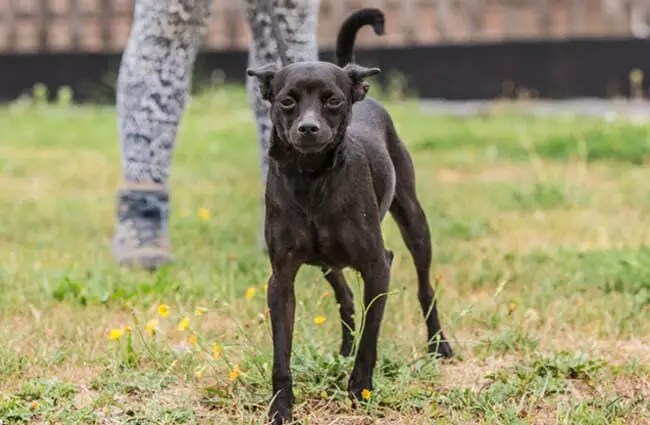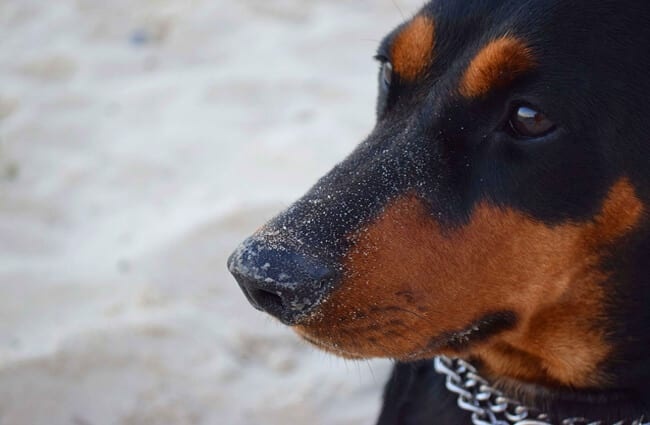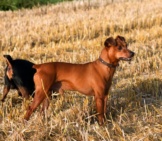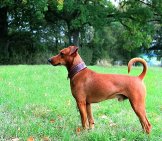The German Pinscher (“GP”) does not look unlike some of his more famous cousins. However, these pinschers are smaller than Dobermans, and solidly colored. These hard-working dogs are intense, but also surprisingly social. Read on to learn more about the German Pinscher.
Description of the German Pinscher
These dogs are little balls of lean muscle, with short and sleek coats that show it off. The GP can come in blue, red, brown, black, and fawn.
There’s no doubt these dogs look impressive, but their medium size means that they are not as intimidating as many working dogs. Still, they’ve got a characteristic pointed muzzle and tall, graceful ears. It’s certain that these dogs are always alert and ready.
The German Pinscher is one of the oldest German breeds, meant to hunt rats. In fact, they were precursors to breeds like the Doberman and Miniature Pinscher.
Life Expectancy and Size
These dogs are quite lean, weighing in between 25 and 45 pounds, and standing between 17 and 20 inches tall.
They generally live between 12 and 14 years. Maintaining their fitness and weight can ensure they live as long as possible.
Protective Ability
This breed does not maintain the guard dog mentality of bigger workers. However, the German Pinscher is an effective watchdog.
Many GP’s are protective of their families, and standoffish with strangers. They will certainly alert you to anything suspicious with their sharp bark! Of course, socialization is important, so these dogs don’t turn skittish or aggressive.
Training
It important to treat the German Pinscher like the smart and capable dogs that he is. Channel this breed’s energy and enthusiasm into positive outlets. This can mean keeping sessions short and engaging.
They respond best to persuasive, consistent commands. Harsh words simply do not work. Like with most dogs, a positive and rewards-based regimen will help these dogs achieve success.
Energy Level
These dogs need to have consistent physical and mental stimulation. Otherwise, they can very easily become bored and potentially destructive. Most German Pinschers are job oriented. Providing them with something to do will keep them the happiest they can possibly be.
What Living with a German Pinscher is Like
Living with this capable dog is a real treat. However, it is important to provide them with enough mental and physical stimulation. Otherwise, they can easily become unhappy. Unlike many other working dogs, this could simply mean long play sessions and brisk walks each day. However, the German Pinscher will likely be happier with some job to perform.
Otherwise, this breed is quite easy-care. They do not shed heavily, and are generally a hardy breed.
Care of the German Pointer
These dogs have an easy-care physique, that can be a good match for any family that enjoys their intense work ethic.
Environmental Needs
The German Pinscher can handle most climates, although their short coats can leave them a bit chilly in the cold unless they are performing vigorous activity. They love being outside, and having a fenced yard is highly advisable. Unfortunately, they can get into trouble quickly off leash.
Exercise Needs
Minimally, these dogs require a fenced area to run and play, and a walk or two each day. Ideally, allow them to join in on fun doggie sports like agility or tracking. This will keep the German Pinscher interested, engaged, and out of trouble.
Shedding and Grooming
This breed’s short coat does shed, so brushing them occasionally with a grooming mitt can help to remove loose hair. Otherwise, care is minimal. You’ll rarely need to bath him. Routine maintenance of the ears, nails, and teeth is recommended, as it is for all dogs. Be sure to address any particular concerns with your veterinarian.
Ideal Home Environment
These dogs are social and will bond closely with their families. Generally, they’ll do okay with family pets as long as they’re introduced slowly and properly socialized.
The German Pinscher would be great for an active family that enjoys playtime outside. Although the doesn’t require directed activity, he would very much enjoy working with an owner that doesn’t mind giving him a job. Families should enjoy their mischievous nature and their intensity.
Health Concerns
Health problems are not a serious concern for this breed. They do have some general trends toward hip and eye problems, as well as some heart and blood clotting issues. Overall, though, the German Pinscher is a healthy, hardy breed
Behavior Problems
Early obedience and socialization training are essential with this breed. This will help these dogs to fulfill their potential for work and personality. Otherwise, they may become standoffish or even territorial.
Some people report possessive tendencies, either with people, toys, or food.
























![Red Angus Closeup of a beautiful Red Angus cowPhoto by: U.S. Department of Agriculture [pubic domain]https://creativecommons.org/licenses/by/2.0/](https://animals.net/wp-content/uploads/2020/03/Red-Angus-4-100x75.jpg)

